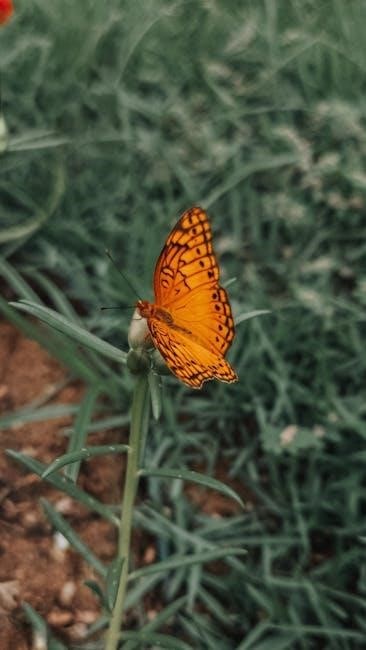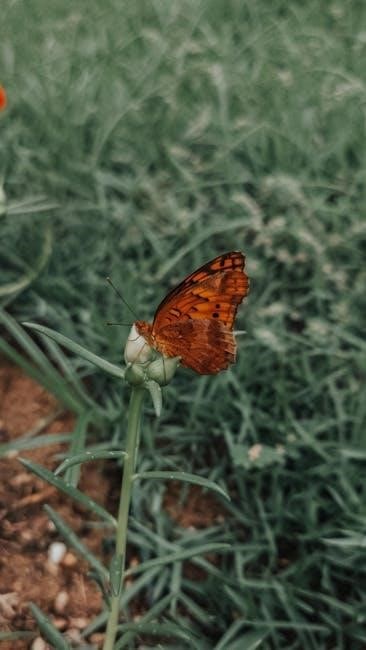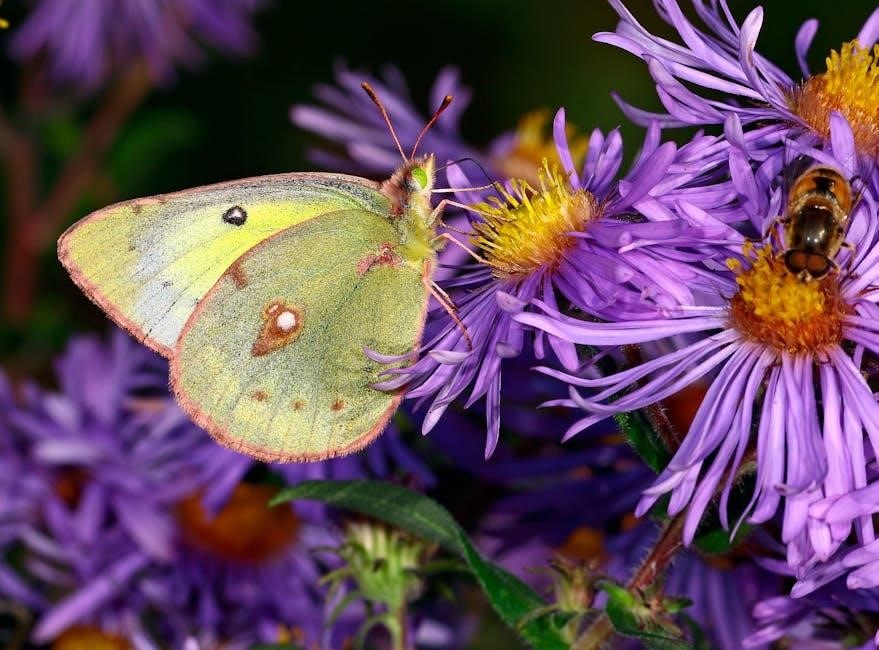Clearwater Butterfly Releases offers a magical way to celebrate life’s milestones with over 15 years of expertise, providing butterfly release services for weddings, memorials, and special events․
1․1 Overview of Clearwater Butterfly Releases
Clearwater Butterfly Releases provides a unique and memorable way to celebrate special occasions with live butterfly releases․ With over 15 years of experience, they specialize in delivering high-quality butterflies for events like weddings, memorials, and new beginnings․ Their services include detailed care instructions, ensuring the butterflies are in optimal condition for release․ They also offer educational kits for raising Painted Lady butterflies, complete with mesh habitats and food, making it easy for anyone to experience the magic of metamorphosis firsthand․
1․2 Popularity of Butterfly Releases
Butterfly releases have gained immense popularity as a meaningful way to celebrate life’s milestones․ They are often used in weddings, funerals, and new beginnings, offering a symbolic and emotional connection․ The magical experience of watching butterflies fly adds a memorable touch to any event․ Their popularity stems from the beauty and tranquility they bring, making them a sought-after choice for creating lasting memories․ Clearwater Butterfly Releases further enhances this experience with educational kits and detailed care instructions․
Preparing for a Butterfly Release Event
Preparing for a butterfly release event requires careful planning, including handling, feeding, and ensuring optimal weather conditions to guarantee the butterflies’ well-being and a memorable experience․
2․1 Steps to Prepare for the Event
To ensure a successful butterfly release, review care instructions thoroughly, store butterflies indoors or in shade until release, and feed them sugar water or fresh fruit slices daily․ Check weather conditions, avoiding rain and temperatures below 70°F․ Gather guests, provide a calm environment, and follow release guidelines․ Proper preparation ensures the butterflies are healthy and ready for a magical experience․
2․2 Caring for Butterflies Before Release
Before release, butterflies need gentle care․ Place them in a shaded area to avoid overheating and provide sugar water or fresh fruit slices daily․ Mist with room temperature water to keep them hydrated․ Avoid disturbing them to prevent stress․ Ensure they are warm enough before release by moving them to a warmer area a few hours prior․ Proper care ensures they are healthy and ready for flight․
Understanding the Butterfly Life Cycle
The butterfly life cycle includes four stages: egg, caterpillar, chrysalis, and adult․ Transformation from caterpillar to butterfly typically takes three weeks; adults live 2-4 weeks․
3․1 Stages of Butterfly Development
The butterfly life cycle consists of four distinct stages․ Eggs hatch into caterpillars within 3-5 days, feeding and growing up to 1 inch long․ They then form chrysalides, where transformation occurs over 7-10 days․ Adult butterflies emerge fully formed, their wings expanding before flying․ This natural process highlights the remarkable metamorphosis, offering a fascinating educational experience for observers of all ages․
Caring for Caterpillars
Caterpillars require proper care, including air ventilation, room temperature storage, and minimal disturbance․ Avoid shaking chrysalides and ensure a stable environment for optimal development into butterflies․
4․1 Instructions for Caterpillar Care
Keep caterpillars at room temperature, ensuring their containers have airholes for ventilation․ Avoid direct sunlight to prevent overheating․ Do not shake the chrysalides, as this can harm development․ Larvae typically hatch within 3-5 days and grow for several weeks before forming chrysalides․ The transformation into butterflies takes about 7-10 days․ Follow the provided care guide or video instructions for detailed steps, ensuring a rewarding experience as you witness their metamorphosis․
Creating a Butterfly-Friendly Environment
Provide native plants for food and shelter, ensuring a natural habitat․ Use shallow dishes with sugar water or fresh fruit slices to attract butterflies․ Maintain shaded areas for resting and protection from harsh conditions․
5․1 Setting Up the Right Space
To create a butterfly-friendly environment, start by setting up a dedicated space with native plants and flowers that provide nectar and shelter․ Place shallow dishes filled with a sugar-water solution or fresh fruit slices to feed the butterflies․ Ensure the area is partially shaded to protect them from direct sunlight and extreme temperatures․ Avoid using pesticides, as they can harm butterflies․ Keep the space clean and well-maintained to encourage their presence and promote a healthy ecosystem for these beautiful creatures․
5․2 Providing Food and Plants
Provide butterflies with a reliable food source, such as a shallow dish of sugar water (1 part sugar to 20 parts water) or freshly cut fruit like watermelon, banana, or orange slices․ Mist the environment daily with room-temperature water to maintain humidity․ Incorporate native nectar-rich flowers and plants, as they attract butterflies and support their nutrition․ Avoid using pesticides, as they can harm these delicate creatures․ Ensure plants are pesticide-free to create a safe and welcoming habitat for the butterflies to thrive․

Handling and Transporting Butterflies
Handle butterflies gently, ensuring their wings remain intact․ Transport them in shaded, cool areas to prevent overheating․ Move to warmer locations before release․
6․1 Safe Handling Practices
Handle butterflies gently, supporting their bodies to avoid wing damage․ Use sugar water to encourage feeding, ensuring they are calm․ Transport in shaded, cool areas to prevent overheating․ Place them in secure, ventilated containers with minimal disturbance․ Before release, move them to a warmer location to activate their flight instincts․ Never handle butterflies excessively, as this can stress them․ Ensure their wings are fully dry before release for optimal flight․
6․2 Transporting to the Release Location
Transport butterflies in a secure, shaded, and cool environment to prevent overheating․ Place ice packs near the container if necessary, ensuring they do not directly touch the butterflies․ Keep the container upright and well-ventilated․ Avoid direct sunlight during transport to maintain optimal conditions․ Upon arrival, allow the butterflies to warm up gradually before release․ Follow care instructions to ensure their safety and readiness for flight․ Handle the container gently to minimize stress during transit․

Ideal Weather Conditions for Release
Release butterflies in calm, sunny conditions with temperatures between 70-85°F․ Avoid rain, direct sunlight, or strong winds to ensure their safety and optimal flight conditions․ Provide shade if necessary․
7․1 Best Weather for Releasing
The ideal weather for releasing butterflies is calm, sunny, and warm, with temperatures between 70°F and 85°F․ Ensure the sky is clear or partly cloudy, avoiding strong winds or direct sunlight, which can overheat the butterflies․ Provide shade if necessary․ Avoid releasing during rain or when temperatures are below 70°F, as butterflies may not fly․ Optimal conditions ensure a successful release, allowing butterflies to fly naturally and safely into their environment․
7․2 Avoiding Inclement Weather
Avoid releasing butterflies during rain, cold temperatures below 70°F, or strong winds, as these conditions can harm them․ If rain is forecasted, postpone the release until the weather clears․ If temperatures are too low, keep butterflies indoors in a shaded, cool area until conditions improve․ Ensure they have access to food and water during delays․ Avoid direct sunlight, which can overheat them․ Proper weather planning ensures the butterflies’ safety and a successful, memorable release experience․
Releasing Butterflies: A Step-by-Step Guide
Releasing butterflies involves gently removing them from their containers and allowing them to fly․ Ensure they are warm and active before release․ Choose a calm, sunny spot away from predators․ Open the container slowly, letting butterflies exit on their own․ Avoid handling them excessively to prevent harm․ Release during optimal weather for their survival․ Watch as they soar, creating a memorable experience․
8․1 Detailed Release Instructions
To ensure a successful butterfly release, follow these steps: Move the butterflies to a warm location a few hours beforehand to activate them․ Choose a calm, sunny spot with temperatures above 70°F․ Gently open the container, allowing butterflies to fly out on their own․ Avoid handling them to prevent damage․ Release during optimal weather conditions, avoiding rain or strong winds․ Provide a sugar water source or fresh fruit nearby․ Watch as they soar, creating a magical and memorable experience for all․
Butterfly Feeding and Nutrition
Butterflies thrive on sugar water solutions (1 part sugar to 20 parts water) and fresh fruits like watermelon, banana, or orange slices․ Provide daily misting for hydration․
9․1 What to Feed the Butterflies
Butterflies primarily consume sugar water, made by dissolving one part sugar in 20 parts water․ Fresh fruits like watermelon, banana, and orange slices are also excellent options․ These foods provide essential nutrients․ Avoid using artificial sweeteners or processed sugars․ Ensure the feeding area is clean to prevent contamination․ Provide a shallow dish for easy access․ Mist watering is also recommended daily to keep butterflies hydrated and active․
9․2 Feeding Frequency
Butterflies should be fed daily to ensure they remain healthy and active․ Offer sugar water solution (1 part sugar to 20 parts water) in a shallow dish․ Fresh fruits like watermelon, banana, and orange slices can also be provided․ Mist the butterflies gently with room-temperature water once a day to maintain hydration․ Avoid overfeeding, as butterflies in release preparation may not require food if they are in a dormant stage․ Follow care instructions for optimal feeding schedules․
Common Mistakes to Avoid
Avoid releasing butterflies in rain or temperatures below 70°F․ Do not handle butterflies excessively or disturb them before release․ Ensure proper care and follow instructions to prevent stress․
10․1 Pitfalls in Butterfly Release
Releasing butterflies in harsh weather, such as rain or extreme heat, can harm them․ Avoid handling butterflies excessively, as this may cause stress or injury․ Ensure butterflies are not released in areas with predators or pesticides․ Ignoring care instructions, like feeding or storage, can lead to poor health․ Release should occur during optimal conditions to ensure their survival and success in the wild, providing a respectful and ethical experience for both the butterflies and participants․

Butterfly Release Etiquette
Handle butterflies gently, ensure optimal weather conditions, and avoid releasing them in harsh environments․ Respect their natural behavior and ensure their safety for a meaningful experience․
11․1 Best Practices and Respect
When handling butterflies, ensure gentle care to avoid harming their delicate wings․ Release them in suitable weather conditions, avoiding rain or extreme temperatures․ Keep them in shaded areas before release to prevent overheating․ Provide a calm environment, minimizing stress; Avoid handling butterflies excessively, as this can cause fatigue․ Ensure all releases align with local regulations and respect the natural habitat․ These practices promote a respectful and ethical butterfly release experience․

Post-Release Care
After releasing butterflies, leave the area undisturbed to allow them to acclimate naturally․ Ensure nearby plants provide food, and avoid disrupting their environment to support their survival․
12․1 Actions After Release
After releasing butterflies, it’s important to leave the area undisturbed to allow them to acclimate․ Ensure surrounding plants provide nectar sources for sustenance․ Avoid using pesticides nearby to protect their health․ Observe from a distance to minimize disruption․ Keep the environment clean and natural, as butterflies may linger for a few hours․ This care ensures their well-being and supports their integration into the natural habitat․
Troubleshooting Common Issues
Common butterfly release issues include poor weather conditions, butterfly lethargy, or failure to fly․ Address these by ensuring optimal temperatures and providing sugar water for energy replenishment․
13․1 Solutions to Potential Problems
For sluggish butterflies, move them to a warmer location to stimulate activity․ If butterflies fail to emerge, gently warm the chrysalis with a heat source․ Ensure proper food and water, like sugar water or fresh fruit, to sustain them․ Avoid handling butterflies excessively to prevent wing damage․ If weather is unsuitable, postpone the release or keep butterflies indoors until conditions improve․ Always follow care instructions provided to address issues effectively․
Clearwater Butterfly Releases offers a magical, memorable experience, combining beauty and expertise to create heartfelt moments for celebrations and farewells, ensuring a seamless journey for all participants․
14․1 Final Thoughts and Encouragement
Clearwater Butterfly Releases offers a transformative experience, blending nature’s beauty with emotional connections․ By following their expert guidance, you can create meaningful moments for celebrations or farewells․ Raising and releasing butterflies fosters education, wonder, and joy, while supporting these creatures’ life cycle․ Embrace this opportunity to connect with nature and leave a lasting impression․ With care and dedication, your butterfly release will be a cherished memory, inspiring others to appreciate these delicate wonders and their role in our world․